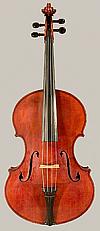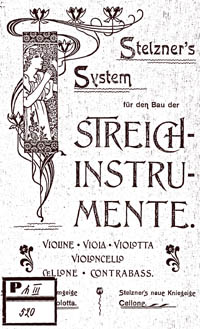Unearthing the Stelzner Story
by James Christensen
To some people, my Alfred Stelzner cello looks like a baroque instrument. Others make odd remarks when they first see it. "I love your f-holes", someone said to me recently. How do you reply to a comment like that?
The cello had rested for a very long time. After new strings, a new bridge, some fiddling with the sound-post, and some playing, it opened up to show its special qualities. It exhibits a uniform timbre on all strings throughout the full range so that the tone quality does not change much in moving from the D-string to the A string, for example, or from the G-string to the C-string, even in high positions. It responds immediately, at all positions and on all strings. Its striking resonance probably accounts for the quality in its sound that I call "presence". Its voice always penetrates in performances with piano and in ensembles. Other Stelzner instruments demonstrate the same characteristics. For a long time, I knew little more of Alfred Stelzner than what Henley had told me. I looked in many reference books, but only a little new turned up. Finally, through a friend in Germany, I reached Dr. Annette Otterstedt of the Berlin Musical Instrument Museum. She sent me copies of newspaper clippings from the files in their library and made many helpful suggestions. That museum had one example of Stelzner’s work and she told me where I could find others in German museums. She mentioned especially the musical instrument museum at Markneukirchen and a violin maker there who, she believed, knew something of Stelzner. I had never heard of Markneukirchen. I overcame the handicap of a monolingual middle-westerner confronting a century-old German literature by seeking the help of a professional translator, Gertrud Champe, then director of translation services here at the University of Iowa. The fact that she was also well schooled in matters relating to music and even violin making made her the ideal person for the job.
In Lübeck, I found Carl-Ferdinand Stelzner to be a charming man about my own age, a retired engineer, fluent in English and eager to talk about his great uncle Alfred. From him I learned more details of Alfred Stelzner’s life and I was able to see the few papers he had left behind, carefully preserved by the family. Carl Stelzner also introduced me to Hermann Leutz, a professional cellist in the Lübeck civic orchestra, a caretaker of stringed instruments possessed by that orchestra, and a collector of cellos. He showed me the Stelzner stringed bass that is owned by and played in the Lübeck civic orchestra, and, later, he showed me a privately-owned cellone.
I also inserted advertisements in appropriate web pages seeking privately-owned Stelzner instruments. Most such instruments belong to non-players, but a few owners actually play them. One, Peter Polderman of Delft, continues to help me to advance my understanding of the history of Alfred Stelzner. Udo Kretzschmann has addressed the special problems of construction of Stelzner instruments in making exact replicas of certain instruments in the museum at Markneukirchen. Of course, much remains for me to learn about Alfred Stelzner. I am curious to learn where he got his education in music and in instrument making, as well as in mathematics and physics. I would like to know where he studied the then-new science of acoustics. I would like to know what he did in the decades between the time he finished his formal education and the time he filed his patents. I would like more detail about the science behind his new designs. I would like to know to what extent he experimented to reach his final designs. Not only did Stelzner redesign the violin sound box, he also invented two new instruments to fill out the gaps in the full range of violin-family instruments, mass- produced them, publicized and promoted them, and composed music to show them off, to considerable acclaim in his own time. Why, then, did the musical world so nearly forget him after his bankruptcy and suicide? Perhaps it was a result of the unusual appearance of his instruments. Perhaps it was because he operated at the fringes of three disciplines, acoustics, violin-making, and music. Perhaps it was because he was a German at a time when Italian instruments were preferred. Perhaps it was because he worked in Saxony, where most of the trashy factory-made violins sold by mail-order catalogs in the United States in the 19th century had come from. Perhaps it was because bankruptcy and suicide were then seen as a sort of moral failure, I continue to work on the story of Alfred Stelzner. Modern violin-makers might learn something from Stelzner’s work if his instruments are available for them to see, and if players tell them about the special qualities that make them so pleasing to play. James Christensen |
[Chamber Music] [Orchestral Music] [Keyboard Music] [Top]
© All contents copyright by the International Draeseke Society
 When I stumbled on my funny-looking cello in Denmark eight years ago, I knew nothing of Stelzner. The dealer’s copy of William Henley’s Universal Dictionary of Violin and Bow Makers contained only a skimpy outline of his life. Astonished at the low price and the power of the instrument, I bought it on the spot.
When I stumbled on my funny-looking cello in Denmark eight years ago, I knew nothing of Stelzner. The dealer’s copy of William Henley’s Universal Dictionary of Violin and Bow Makers contained only a skimpy outline of his life. Astonished at the low price and the power of the instrument, I bought it on the spot. 
 In Markneukirchen, I met Udo Kretzschmann, the violin maker whom Dr. Annette Otterstedt had recommended, and Heidrun Eichler, the director of the musical instrument museum. She let me examine all the Stelzner instruments in the museum’s collection, and Udo Kretzschmann pointed out to me some of the unique design features of the instruments. They also told me which other museums in Europe have Stelzner instruments. On later trips to Germany, I was able to see those instruments in Halle, Berlin, Leipzig, Nuremberg, Bochum, and Paris. Nearly all of the Stelzner instruments in these museums remain in storage, not on display.
In Markneukirchen, I met Udo Kretzschmann, the violin maker whom Dr. Annette Otterstedt had recommended, and Heidrun Eichler, the director of the musical instrument museum. She let me examine all the Stelzner instruments in the museum’s collection, and Udo Kretzschmann pointed out to me some of the unique design features of the instruments. They also told me which other museums in Europe have Stelzner instruments. On later trips to Germany, I was able to see those instruments in Halle, Berlin, Leipzig, Nuremberg, Bochum, and Paris. Nearly all of the Stelzner instruments in these museums remain in storage, not on display.  a scandal. And perhaps it was the result of the economic chaos and the two great European wars of the rest of the century, one of which destroyed Dresden, Stelzner’s city.
a scandal. And perhaps it was the result of the economic chaos and the two great European wars of the rest of the century, one of which destroyed Dresden, Stelzner’s city. 